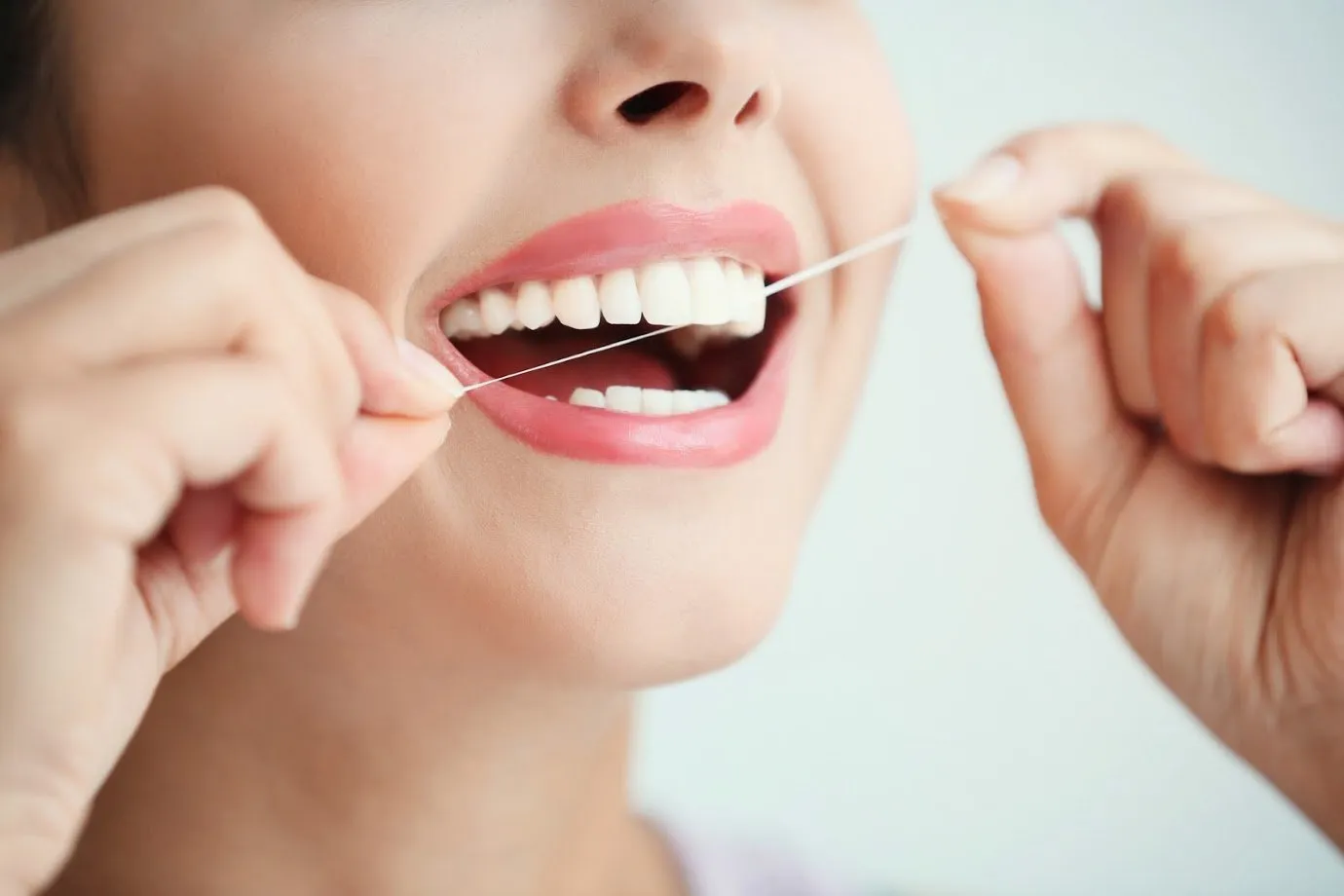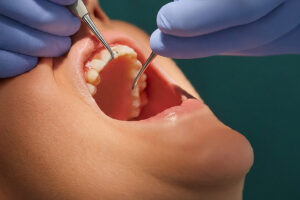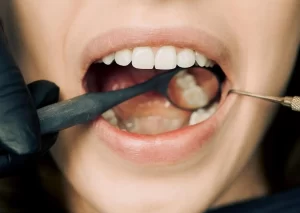Tartar Broke off While Flossing! What Should I do Now?

Flossing is an integral part of maintaining good oral hygiene, aimed at removing plaque and food particles from areas your toothbrush can’t reach. This is why experiencing tartar breaking off teeth while flossing can be an alarming experience.
Tartar, also known as dental calculus, is hardened plaque that has firmly attached to the tooth surface. It can lead to a variety of dental issues, including gum disease and tooth decay, if not properly managed.
In this article, we delve into the reasons behind tartar detachment during flossing, its implications for your oral health, and the steps you can take to prevent such occurrences.
Table of Contents
What Should I Do If Tartar Breaks Off While Flossing?
If tartar breaks off while you’re flossing, it can be scary, but you shouldn’t worry too much.
Here’s what you should do:
Don’t Panic
Try not to panic. Tartar breaking off can be surprising, but it’s not always a sign of a major dental problem. It may indicate that the tartar was already loosened, possibly due to your diligent oral hygiene routine.
Examine Your Mouth
Gently examine your mouth to see if there are any sharp edges or discomfort that might indicate a larger piece of tartar has broken off. Be cautious not to poke or prod too hard, as this could cause injury to your gums or teeth.
Rinse Your Mouth
Rinse your mouth with warm salt water or an antiseptic mouthwash. This can help clean the area and remove any small particles that may have been dislodged along with the tartar.
Continue Your Oral Hygiene Routine
Continue with your regular oral hygiene routine, including brushing twice a day and flossing daily. This will help prevent further plaque and tartar buildup.
Monitor for Any Changes
Keep an eye on the area where the tartar broke off. Look out for signs of irritation, swelling, or bleeding. If you notice any changes or if the area becomes painful, it may be time to consult your dentist.
Schedule a Dental Check-Up
Even if there are no immediate signs of discomfort, it’s a good idea to schedule a check-up with your dentist. They can examine your mouth to ensure there’s no underlying damage and perform a professional cleaning to remove any remaining tartar.
Discuss Preventive Measures
Use this opportunity to discuss with your dentist any preventive measures you can take to avoid future tartar buildup. This might include improvements to your brushing technique, the use of specific dental hygiene products, or more frequent professional cleanings.
Consider Professional Cleaning
If tartar frequently breaks off or if you have a significant buildup, professional cleaning by a dentist or dental hygienist is necessary. They have the tools and expertise to safely remove tartar without damaging your teeth or gums.
If you are thinking about how to remove tartar from teeth without a dentist, I don’t recommend trying it. There are some home remedies you can try to improve your situation, but the best option is to see your dentist and let a professional treat you.
What Broke Off Of My Tooth When I Was Flossing?
If you notice something breaking off of your tooth while flossing, it’s important to determine whether it was tartar (dental calculus) or a piece of the tooth itself.
Here’s how to identify what broke off and what steps you should take next:
Identifying What Broke Off
- Tartar: Tartar is hardened plaque that has accumulated on the teeth. It can vary in color from yellow to brown. If the piece that broke off is hard, crusty, and was attached to the surface or between the teeth, it’s likely tartar. Tartar removal can sometimes happen during vigorous flossing, especially if it was already loosened by previous dental hygiene activities.
- Tooth Fragment: A piece of the tooth might break off due to decay, injury, or weakness. This fragment could be part of the tooth’s enamel, a filling, or a part of a decayed tooth. It might feel harder than tartar and more integral to the tooth’s structure. If you’re unsure, compare the broken piece to your teeth. Look for a missing part or a new rough or sharp edge on your tooth.
Steps to Take
- Examine your mouth: Carefully check your teeth and gums in a mirror. Look for any visible damage or changes to your teeth where the piece broke off.
- Rinse: Rinse your mouth with warm salt water to clean the area and reduce the risk of infection.
- Save the fragment: If possible, save the broken piece in a clean container. If it’s a part of the tooth or a filling, your dentist may want to see it.
- Avoid using the damaged tooth: Try not to chew on the side of the mouth where the breakage occurred to prevent further damage.
- Contact your dentist: Schedule an appointment with your dentist as soon as possible. Explain what happened and describe the piece that broke off. Your dentist will need to examine your mouth to determine the next steps, whether it’s removing remaining tartar, repairing the tooth, or other treatments.
- Follow dental hygiene practices: Continue with your oral hygiene routine, being gentle around the affected area until you can see your dentist.
Preventing Future Breakage
- Maintain regular dental check-ups and cleanings to prevent tartar buildup and to catch any potential issues early.
- Ensure you’re using proper flossing techniques to avoid damaging your teeth and gums.
- Consider using tools like soft picks or water flossers if traditional flossing is challenging or if you have a lot of tartar buildup.
Preventing tartar buildup
Here are effective strategies to prevent tartar buildup:
Maintain good Oral Hygiene
- Brush Twice a Day: Use fluoride toothpaste and a soft-bristled toothbrush. Brush for two minutes, ensuring you cover all surfaces of your teeth.
- Floss Daily: Flossing removes food particles and plaque between teeth where a toothbrush can’t reach.
- Use an Antiseptic Mouthwash: This helps kill bacteria that contribute to plaque formation.
Choose the Right Toothpaste
Opt for toothpaste containing anti-tartar ingredients like pyrophosphates and zinc citrate, which can help prevent tartar formation. Some toothpastes also contain triclosan to fight plaque and bacteria.
Eat a Balanced Diet
Limit sugary and starchy foods that can contribute to plaque formation. Instead, eat plenty of fruits, vegetables, and foods high in fiber to stimulate saliva flow, which helps protect against cavities and tartar buildup.
Quit Smoking
Smoking is a significant risk factor for the development of tartar and gum disease. Quitting smoking can greatly reduce the likelihood of tartar buildup and improve overall oral health.
Regular Dental Checkups
Visit your dentist at least twice a year for professional cleanings and checkups. These visits allow removing tartar that can’t be eliminated with at-home care and for catching any potential issues early.
Consider Dental Sealants
For individuals prone to tartar buildup, dental sealants can provide an additional layer of protection against plaque and tartar on the back molars, where decay often starts.
Stay Hydrated
Drinking plenty of water helps wash away food particles and bacteria in the mouth, reducing the risk of plaque and tartar formation.
Use Dental Tools Appropriately
If you use interdental brushes or water flossers, ensure you’re using them correctly to avoid damaging your gums and enamel.
By incorporating these strategies into your daily routine, you can significantly reduce the risk of tartar buildup and maintain a healthy, beautiful smile.
What other dental conditions may seem like it but is not fallen off tartar?
A condition that may seem like tartar has fallen off but is actually different is a missing filling. This condition shares similarities with fallen-off calculus, such as the sensation that something is missing in your mouth and a sharp feeling when you run your tongue over the area.
A key difference is that a missing filling is likely to be sensitive or potentially painful because it exposes dentin, whereas fallen-off tartar reveals enamel underneath, which does not lead to sensitivity or pain.
FAQ on Tartar Broke off While Flossing
What happens if tartar breaks off?
If tartar breaks off, it indicates the tartar was not fully mature and could be removed with flossing. This occurrence suggests an opportunity to seek dental care to prevent further maturation and complexity of tartar buildup. Early intervention may allow for simpler, less costly dental treatments, such as regular cleaning, rather than more extensive procedures required for fully matured tartar.
Why is my tartar breaking off?
Can tartar just break off?
How do you break up tartar on the back of your teeth?
Breaking up tartar on the back of your teeth at home is challenging and not typically recommended, as tartar is hard and firmly attached to the tooth surface. The most effective way to remove tartar is by visiting a dentist or dental hygienist for a professional cleaning. They use specialized tools to safely and effectively remove tartar without damaging the teeth or gums.
Can Tartar Come Off with Flossing?
Yes, tartar can come off while flossing, especially if it is in the early stages of maturation and string floss is used. This does not happen with water flossers, as they cannot hook underneath the tartar to remove it. The ability to remove tartar through flossing indicates it has not yet fully matured.
What is The only floss that can break off tartar?
The only type of floss that can potentially break off tartar from your teeth is string floss. This is because, under certain conditions, you can sometimes hook the string floss underneath the tartar and remove it with brute mechanical force. Water flossers, on the other hand, cannot achieve this because they cannot hook underneath the tartar; they are effective at removing soft plaque but not hard tartar that is almost bonded onto the tooth surface.
How mature is the tartar?
The only opportunity to remove tartar with flossing is when it is in the early stages of maturation and has not yet fully matured. Early-stage tartar is only slightly harder than plaque but significantly softer than mature calculus. Catch it while it is still young and not completely mature, as this is the only time tartar can be removed without professional dental intervention. Once tartar matures, it becomes rock solid, making it impervious to all home remedies, and only a dentist or dental hygienist can remove it.
Fact Checked
Our dedicated team rigorously evaluates every article and guide to ensure the information is factual, up-to-date, and free of bias.
Updated Regularly
We update our articles and reviews regularly to ensure you have access to the latest data in the dental industry.
The content on Dental3DU’s blog is intended for educational purposes only. This information should not be relied upon as professional medical counsel. Be sure to always consult with your dentist about the dangers and benefits of any medication, treatment or procedure.







